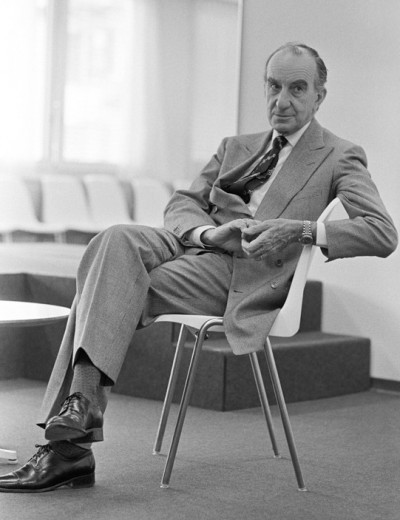Emilio Pucci di Barsento, Marquis of Barsento, was born in 1914. He spent two years at Milan University, before moving to the University of Georgia in Athens, Georgia, USA for a further two years of study.
In 1934 he was a member of the Italian Olympic ski team. In 1937, he won a skiing scholarship to Reed College in Oregon. There he majored in social sciences and received his MA two years later in 1939. He made his first venture into fashion by designing the uniforms for the Ski team.
Being born into an aristocratic family, he was the first Pucci to actually work in over 1,000 years. But he spared his family honour by signing his work only as "Emilio".
Returning to Italy, he spent the war years as a bomber in the Italian Air Force. He was awarded a doctorate in political science from the University of Florence in 1941. Pucci was a keen sportsman and as a high school student had been a member of the Italian Olympic ski team.
After World War II, in 1947, he was photographed by Toni Frissell of Harper's Bazaar on the Italian ski slopes, wearing ski pants of his own design. The magazine asked him to create some winter clothes for women, which it subsequently published and which per put on sale in various New York stores.
In 1949, Pucci opened a boutique in Capri, selling the range of his interesting items but especially "Capri Pants" which took the world by storm. In 1951, the first fashion show took place in Florence.
During the 50's, Pucci gained a reputation as a designer of brilliantly patterned sporting wear and relaxed daywear. He contributed to the success of post-war Italian fashion design. He used silk jersey for his dresses which were light weight, wrinkle free and supremely comfortable.
In addition to his life of fashion, Pucci was a well-known fascist and wrote a defense of the Mussolini regime as an undergraduate at Reed College. In 1965 he became a member of the Italian parliament.
Also in 1965, Pucci was hired by New York ad agency Jack Tinker and Associates to re-design the hostess wardrobes for Braniff International Airways.
In 1959, Emilio Pucci married Cristina Nannini, and their daughter Alessandro was born the same year. Their second daughter Laudomia was born in
1961. In 1962, Pucci's first haute couture collection was shown, and he mentioned that it was homage to Jacqueline Kennedy.
In the 60's he produced tapered trousers, Capri pants, shorts, resort dresses, silk blouse and shirts, slacks and casual suits. He also designed ranges of underwear, sweaters and swimwear for US manufacturers. His clothes were known for their brilliant colours and well-defined prints. He led the way for the colourful revolution of the 60's. Pucci's designs have reached strange places.
The Apollo 15 space crew carried a Pucci-designed flag for planting on the moon.
In 1977, he designed the Lincoln Continental Mark IV for the Ford Motor Company.
In 1989-1990 there was a sudden boom on Pucci prints again.
In 1990 Emilio Pucci retired from active design work. On behalf of her father, his daughter received the Council of Fashion Designers of America Award in New York in 1991. The following year, the Costume Museum in the Palazzo Pitti in Forence displayed some of Pucci's most famous pieces.
He died in 1992 at the age of 78. The clothes which Emilio Pucci designed over the years are valued immensely and vintage gowns are treasured. Many exhibitions are held, which was very well attended.
the label
Emilio Pucci: a story which began in 1947 with the chance photograph of a woman in an outfit on his design, is still evolving.
His 30 year old son, the Marchese Alessandro Pucci di Barsento, took over the running of the family business and estates. However, sadly, Alessandro was killed in a car accident in 2000 near Florence, Italy.
For a while his sister Laudomia handled the creative designing. The house of Pucci still however goes on reviving the fashion house's glory days to make it relevant for a new generation. Capitalizing on Pucci's bold, instantly recognizable prints, The Pucci revival has been gathering momentum for several years. The Pucci family began launching new products to appear to these new fans.
Finally, the company was sold to luxury goods conglomerate LVMH who own Dior, Givenchy and many other houses.
In November 2000, LVMH president Arnault asked Puerto Rican designer Julio Espada to reconceive the Pucci clothing collection. Espada, in his Spring 2002 collection, showed plenty of pretty girly shorts, scarves and short crisp cotton dresses. Espada left Pucci in April 2002.
This decisive step has already begun to enhance and reinvigorate the remarkable potential of Emilio Pucci. In addition to the historical Emilio Pucci boutique in New York, newly designed stores, stretching across the globe form Palm Beach to Saint Moritz to Bangkok.
First unveiled in 2001, Emilio Pucci furniture collections, conceived yearly in co-operation with renowned furniture designer Cappellini, mark a brilliant return to design.
In mid 2002 famed French designer Christian Lacroix was named Artistic Director at Pucci.
Pucci is opening the doors of it's new Fifth Avenue flagship store in New York on September 7th 2004, and throwing a party which will be the highlight of New York Fashion Week.
It has been announced that after Christian Lacroix completes his Spring/Summer 2006 collection for the house of Pucci, the design will be taken over by Matthew Williamson from the Autumn/Winter 2006 collection.
